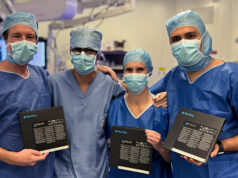Benjamin W Starnes, chief of Vascular Surgery at the University of Washington, USA, and one of the world’s foremost authorities on the treatment of abdominal aortic aneurysms, has announced midterm results from his physician-sponsored investigational device exemption (IDE) study, administered in conjunction with Harborview Medical Center, Seattle, USA. The ongoing study evaluates physician-modified endovascular grafts (PMEG) for the treatment of juxtarenal aortic aneurysms and assesses a new technology developed by Aortica that could significantly reduce the need for invasive open surgery in patients with aneurysms originating too close to branch arteries that supply blood to vital organs. Results from the first 60 patients using manual planning were recently published in the February issue of the Journal of Vascular Surgery (JVS).
The midterm results (out to four years) in non-operative candidates are highly favourable and confirm an early report of clinical success with low morbidity and mortality. Ninety-four per cent of patients met the primary effectiveness endpoint and the overall major adverse event rate was low at 12%. In addition, no patient required conversion to open surgical repair. “With a remarkably low rate (6%) of aneurysm-related mortality, 100% branch artery patency, and no type Ia endoleaks out to four years along with a sac regression or stabilisation rate of 95%, this report supports the use of fenestrated endografts as an effective and durable repair in patients who suffer from juxtarenal abdominal aortic aneurysm,” stated Starnes.
“In our study, we utilise a system which dramatically simplifies the FEVAR procedure,” Starnes added. “The system digitises a patient’s CT scan, utilises software algorithms to account for the effect of the implant on the geometry of the anatomy, and creates an exact replica of each patient’s aortic anatomy as it would look with the introduction of the implant. We then modify an ‘off-the-shelf’ endograft with fenestrations to precisely match each patient’s anatomy.”
The system has been advanced by an early stage privately-held company founded by Starnes called Aortica, which has replicated and automated the manual technique that Starnes has used successfully in over 300 cases. The AortaFit automated FEVAR case planning software was incorporated into his study in early 2016 and has been used successfully in over 20 patients.
Starnes continued, “These midterm results exceed those of alternative therapies in high-risk patients and surpass even standard EVAR in several studies. We have found that a well-planned fenestrated EVAR will optimise two critical success factors. First is the “effective seal zone length,” meaning by using fenestrations we place the graft higher up in the aortic anatomy and obtain seal from the proximal edge of the graft fabric all the way to the beginning of the aneurysm. This allows for secure anchoring of the endograft in healthy parallel walled aortic tissue. Second is “circumferential seal zone,” meaning by using fenestrations rather than scallops we create a circumferential seal along the entire effective seal zone length. I believe these are key factors contributing to the absence of type Ia endoleaks out to four years. We are securely anchoring and sealing the fenestrated endograft in healthy aortic tissue while allowing continued blood flow to vital arteries,” stated Starnes. “As we gain more experience with the automated approach using the AortaFit system, the next step will be collaboration with an endograft manufacturer, moving beyond physician modification of endografts to a more elegant, simplified and rapid direct manufacture of a FEVAR graft. I believe FEVAR will then become the preferred method of treatment for the vast majority of juxtarenal abdominal aortic aneurysm patients and perhaps any abdominal aortic aneurysm patients with disease in the infrarenal neck.”













